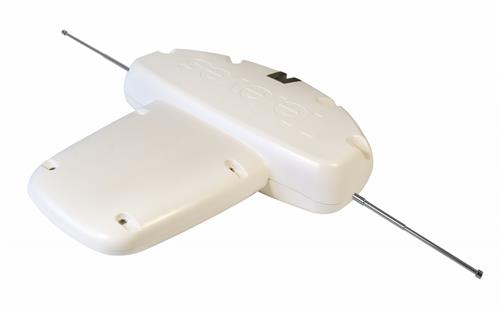Here’s an interesting one. A customer contacted us just to say they were happy with their antenna. They had bought a Televes Dinova Boss Mix like the one you see above. This antenna is designed to receive signals from channels 7-36. Our customer had this to say:
I’m getting channels 2 and 4 with this antenna. I didn’t think this was possible! I wanted to thank you, but I’m also a little confused and I’d love to know exactly what’s going on here.
Answer 1: Maybe it’s not really channel 2
It’s an interesting question and the answer goes back to the mid-2000s when the government was trying to manage the transition between regular TV and digital TV. At that time every station was given access to a second frequency, often in the UHF band, so they could broadcast their old analog signal and their new digital signal at the same time. UHF frequencies were chosen because they travel long distances better and because there are so many more available channels.
This created problems, because (for example) your channel 2’s digital signal might be found on channel 36. Stations that had spent decades building a brand based on their channel numbers were outraged that they might have to permanently move to a new home on the VHF band.
The answer was PSIP – the Program and System Information Protocol. It’s a separate included in every digital television broadcast. The rules allow any station to display their old channel number instead of the new one, and PSIP works kind of like a “shortcut on the desktop” so that when you choose (for example) channel 2, it tunes to channel 36. It displays as channel 2 on your screen and you’re none the wiser. Once an hour, by law, stations must to show their real channel IDs. You’ll see them flash by at the top of the hour usually.
So even though you think you’re tuning to channel 2 or channel 4, our tools can tell what channels you’re really tuning into, and we can recommend an antenna based on what you really get. So you may not need that massive VHF antenna, just a more compact UHF one.
Answer 2: Maybe it really is channel 2 after all
Let’s say for the sake of argument that the customer told us they were getting signals from VHF channel 2. (They weren’t, but let’s pretend.) It is possible that the antenna was picking them up anyway.
As our intrepid antenna expert Phil Karras will tell you, an antenna isn’t a terribly complex thing. It’s a piece of metal. And literally any piece of metal can work as an antenna for any purpose. It’s just a question of how well it does.
If the signals coming from channel 2 are strong enough, you’ll pick them up on anything from a UHF antenna to a coat hanger. So in a case like this, maybe the broadcast towers are ten miles away and the person has a clear line of sight. It’s very possible. Remember that people used to get TV reception with a rabbit-ear antenna on top of the TV and that worked (sometimes.)
We generally don’t recommend small antennas for VHF-Low reception, but if someone does get lucky, like the customer who started this whole discussion, it’s just an extra benefit.
Get the advice you need
Are you looking to get a new TV antenna? Free, over-the-air television will work when pay TV and streaming won’t. It’s a buy-once, use-forever solution. Get that antenna up on the roof, or in the attic, or even inside the house, and you can use it for free. Period.
If you need good advice, call the experts at Solid Signal. We’re here for you during East Coast business hours. When you call, you’ll get a real certified antenna technician, not a script reader. The number is 888-233-7563. If it’s after hours, fill out the form below. We’ll get back to you as soon as we can!





